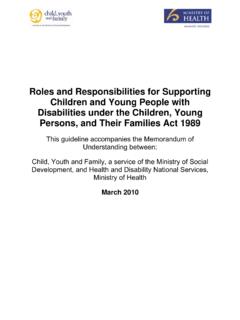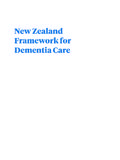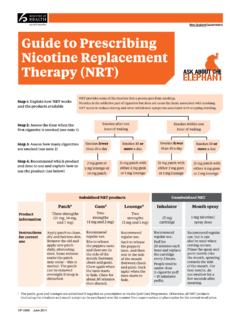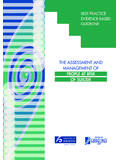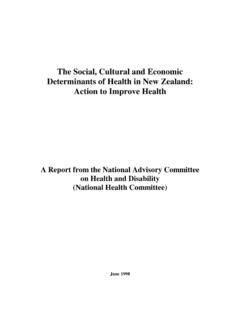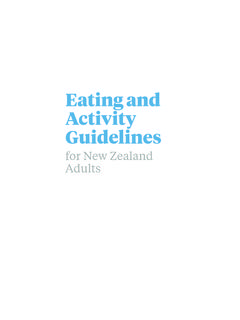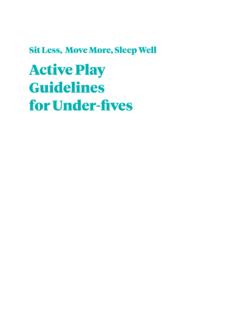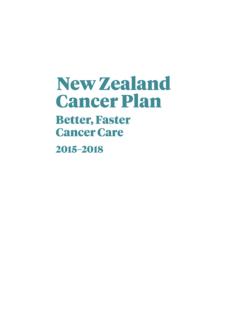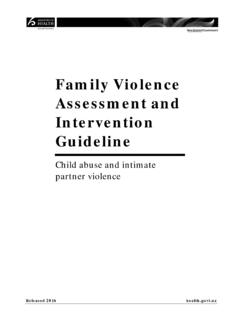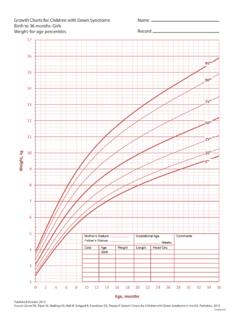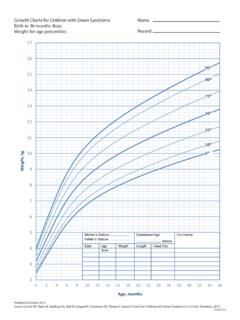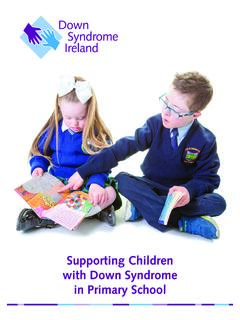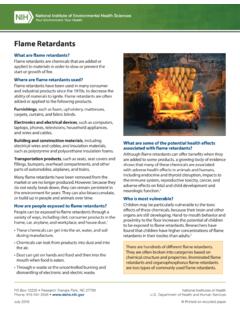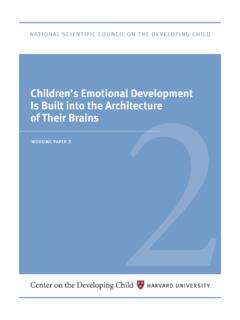Transcription of The Clinical Assessment and Management of Children, Young ...
1 The Clinical Assessment and Management of children , Young People and Adults withDown SyndromeRecommended Clinical Practice Published in October 2001 by the Ministry of Health PO Box 5013, Wellington, New Zealand ISBN 0-478-26209-4 (Web) ISBN 0-478-26210-8 (Book) HP 3472 This document is available on the Ministry of Health s Web site: The Clinical Assessment and Management of children , iii Young People and Adults with down Syndrome Preface A person with down syndrome should be able to share the same experiences in life as any typically developing individual. The child, and later the adult, with down syndrome benefits from a well informed, supportive and supported family working in partnership with professionals from health, developmental therapy, education and disability support services. This document began from a suggestion to provide more consistency in the medical Management of Young children with down syndrome.
2 However, the needs of individuals with down syndrome change as they grow and develop at different times the focus will involve medical care, therapy, education, vocational and social support. Ongoing regular multidisciplinary review by professionals well known to the family allows Assessment and screening, the provision of advice, and advocacy for health, education and disability resources. As a result, this Recommended Clinical Practice document has evolved to provide guidance for individuals throughout the lifespan. Acknowledgements The Ministry of Health would like to thank Dr Warwick Smith, General and Development Paediatrician, for his significant contribution to the writing of this document. The Ministry would also like to thank Dr Leo Buchanan for his work on the M ori perspective section. In addition, the following people have provided important reviews and support: Dr Salim Aftimos Dr Elizabeth Allen Dr Innes Asher Mr Colin Barber Mr Michael Barnes Dr Anne Bray Dr Simon Chin Dr Patricia Clarkson Dr Wayne Cutfield Diane Doehring Dr Matt Eggleston Jane Dravitski Dr Paul Hoffman Dr Carolyn Hope Linzi Jones Hugh Kininmonth Dr Rosemary Marks Lesley Max Dr Justin Mora Dr David Newman Beryl Overall Dr Teuila Percival Ann Smaill Mary Smith Bridget Snedden Paula Sole Beverly Stewart Professor Barry Taylor Dr Rita Teele Dr Pat Tuohy Dr Peter Watson Oriole Wilson Dr Ingrid Winship Multiple general practitioners The Clinical Assessment and Management of children , v Young People and Adults with down Syndrome Contents Preface iii Acknowledgements iii Introduction 1 PART I.
3 A GENERAL OVERVIEW OF down SYNDROME 3 1 Overview of Major Clinical Features 3 Neonatal features 3 Growth 3 Neurodevelopment and cognitive ability 4 Immunity 4 Specific conditions 4 2 General Information About down Syndrome 5 Incidence 5 Genetics and recurrence risk 5 3 A M ori Perspective 6 PART II: RECOMMENDED Management OF INFANTS, children AND ADULTS with down SYNDROME 8 4 Prenatal Counselling and Future Care Planning 8 Prenatal counselling 8 Counselling at birth 9 5 Newborns (Birth to 1 Month) 10 Clinical Assessment 10 Anticipatory guidance 11 6 Infancy (1 Month to 1 Year) 14 Clinical Assessment 14 Anticipatory guidance 16 vi The Clinical Assessment and Management of children , Young People and Adults with down Syndrome 7 Early Childhood (1 to 5 Years)
4 17 Clinical Assessment 17 Cardiorespiratory 17 Anticipatory guidance 19 8 Late Childhood (5 to 13 Years) 21 Clinical Assessment 21 Anticipatory guidance 22 9 Adolescence to Early Adulthood (13 to 21 Years) 23 Clinical Assessment 23 Anticipatory guidance 24 10 Adulthood 26 Clinical Assessment 26 Anticipatory guidance and screening 29 Appendices Appendix 1: Developmental Milestones 32 Appendix 2: Resources for Parents and Caregivers 33 Appendix 3: Antibiotic Prophylaxis of Bacterial Endocarditis 38 Appendix 4: Disability Support Services 39 Appendix 5: Special Education 40 Appendix 6: Readings 42 Appendix 7: Clinical Aspects of Atlanto-axial Subluxation 44 Appendix 8: Growth Charts 46 Appendix 9.
5 Health and Welfare Chart 56 References 57 The Clinical Assessment and Management of children , 1 Young People and Adults with down Syndrome Introduction This document aims to ensure that the health, developmental, educational and psychosocial needs of individuals with down syndrome and their families are identified and addressed, and that individuals with down syndrome receive care that is appropriate, timely and well co-ordinated between primary and secondary care. The recommended Clinical practice (RCP) provided here should be used to supplement routine well child and adult care. This RCP document has been developed mainly for medical health professionals to use with parents and other caregivers to ensure comprehensive and collaborative health care. Inevitably they address the typical needs of the individual with down Syndrome, and do not take into account the differences in personality and achievement that are as varied as they are for all individuals.
6 In some cases a greater level of care will be necessary. For the individual with more complex needs, this RCP helps to ensure that standard medical screening is not overlooked, especially when responsibilities are shared between primary and secondary care. The recommendations for medical visits are therefore considered a minimum, and some individuals will have more frequent contact. The recommended GP visits have been planned to coincide with the current immunisation schedule (2001). The impact of frequent visits to health providers and associated professionals should not be overlooked. They can be disruptive and time demanding. Also, the passing of milestone ages without attainment and a repetitive focus on what the child cannot do are often an extra source of grief to family members. Health professionals, including the GP and paediatrician, can exert an important influence by having a positive approach.
7 This means looking at how well the child is doing within their own frame of reference, and phrasing statements positively. It is important to remember that children , Young people and adults with down syndrome may have better understanding than verbal expression. This should be taken into account if discussing issues when the child is present. When children are present it is important, as with all children , that the child is not discussed in the third person but is included in a way that is appropriate to their level of understanding. As with all children , information should be presented in a developmentally appropriate way that takes into account their cognitive level and level of maturity. It is vital to emphasise the strengths of the child and family, not the problems and procedures. Assessment and treatment should address the holistic needs of the child and family.
8 children , Young people and adults with down syndrome may have similar medical problems, but they are all individuals who have unique personalities and characteristics. They also have a right to participate as fully as possible in society, and this includes both them and their families being active, informed participants in the care they receive from health professionals. When any medical procedures are undertaken, appropriate support and explanation for the child is important which should be appropriate to the child s development. As the child s capacity to comment increases, consideration should be given to them being an increasingly active and informed participant in the care they receive (see Consent in Child and Youth: Information for Practitioners, Ministry of Health, 1998, refer ). Informed consent is an important issue to be aware of in this area for adults with down syndrome also.
9 The Health and Disability Codes should be used as the guide in this area. 2 The Clinical Assessment and Management of children , Young People and Adults with down Syndrome The development of this document involved a review of the literature with the assistance of the New Zealand Health Technology Assessment (NZHTA) unit of the Christchurch School of Medicine. One member of the group assessed these reviews according to the quality of their search processes, the rigour of their analysis and the specific topics covered. The areas of interest covered included screening, medical assessments and treatments, anticipatory guidance regarding health checks, and the identification and appropriate referral for developmental, psychosocial, mental health, educational, vocational and support needs. In general, while certain recommendations are based on observational studies, many represent a consensus of expert opinion and a review of the literature (AAPCG 1994; AAP 2001; down Syndrome Medical Interest Group 1999; Pueschel et al 1995; Piachaud et al 1998; Trumble 1998; Cooley and Graham 1991).
10 The Health Guidelines for children with down Syndrome (AAPCG 1994) and the down Syndrome Preventive Medical Check List ( down Syndrome Medical Interest Group 1999) were especially useful. The New Zealand Disability Strategy, released on 30 April 2001, aims to eliminate barriers that prevent or reduce the participation of people with disabilities in their communities and New Zealand society. These barriers range from the physical, such as access to facilities, to the attitudinal, due to poor awareness of disability issues. By poor awareness, the medical impact is not the issue but rather how people with disabilities are valued and supported in society. When delivering medical services, it is important to remain aware that the medical impact does not exclude the need to value people with disabilities, and to present an attitude that values the lives of people with disabilities and aims to continually enhance the full participation of disabled people in all aspects of life.
